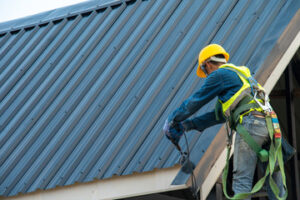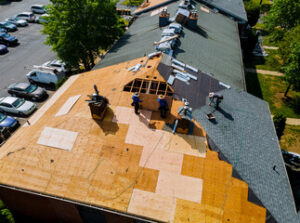Palm Coast Roofers install, repair, and replace roofs on buildings. They use a wide range of materials to create watertight and weatherproof structures. They often work at heights and must follow strict safety procedures.

Roofing professionals are not as vulnerable to economic downturns as other construction trades. The consistent need for re-roofing and repair work keeps this career steady.
Roofers use their skills and training to install, replace, and repair roofs on buildings. They follow a meticulous process to ensure the structural integrity of the building and prevent water leaks. They also work on a variety of rooftops, including flat and sloped structures. They may specialize in the installation of particular roofing materials, such as shingles or metal panels. Additionally, they may be tasked with installing ventilation systems on roofs.
Prior to beginning the installation process, a roofer must prepare the surface by removing existing material and repairing damaged areas. They may then lay down layers to create a durable roof covering, starting with a waterproof barrier and then applying the roofing material of choice, whether that is traditional or solar shingles or long-lasting metal. They also install flashing around chimneys, vents, and other rooftop elements to keep water from seeping into the building.
A roofer must be comfortable working in a variety of weather conditions. Depending on the climate in their region, they may need to be adept at working on sloping rooftops or even climbing ladders and scaffolding to reach difficult areas of the roof. They also need to be proficient at handling tools and materials, as well as understanding how the different types of roofing materials work together.
As part of the installation process, roofers must carefully plan out their work and determine the best way to approach each task at hand. This can involve studying construction plans and analyzing the type of structure to make sure that it follows local building codes. They also need to understand how the materials they are using will impact the structure, such as by reducing or increasing its weight capacity.
Often, roofers must communicate with clients to receive instructions or feedback on the progress of their work. This requires customer service skills and cultural sensitivity to effectively interact with customers. In addition, roofers must be able to read and interpret blueprints and other technical documents in order to properly inspect and install roofs. They also need to have good physical strength and endurance in order to carry out strenuous tasks on rooftops.
Repair
Roofers repair and replace the roofs of structures using a variety of materials. They also spray roofs, sidings, and walls with material to bind, seal, insulate, or soundproof sections of structures. They may inspect problem roofs to determine the best repair procedures and set up scaffolding to provide safe access to roofs.
If you get a new roof, the roofers may either (1) add another layer of shingles on top of the existing ones; or (2) completely remove the old shingles and replace them. With option (1), the roofers wouldn’t be able to see the sheathing or weather-resistant barrier (WRB) beneath the shingles and would be unable to know of any soft spots in the WRB or sheathing.
If you find a soft spot in your roof, the best approach is to send the roofers a recorded letter explaining the problem and giving them a specific amount of time (e.g. ten days) to respond and conduct the repairs. This will allow you to document the roofer’s response and ensure that they cover the cost of the repairs.
Maintenance
Roofers use their skills to install, repair, and maintain roofs on residential and commercial buildings. They often work as part of a team with other construction specialists, such as electricians and carpenters. Roofers must be comfortable working at heights and using ladders, harnesses, and other safety equipment. They also collaborate with project managers and supervisors to ensure that work is done in a timely manner and that all job site regulations are followed.
During the installation process, roofers take careful measurements to determine the amount of roofing materials needed. They then lay down layers of the chosen material to create a durable and waterproof barrier over the building’s structure. In some cases, roofers may also need to attach vapor barriers or weatherproof the seals around vents, chimneys, and other rooftop structures.
When performing maintenance on existing roofs, they assess the condition of shingles and other roofing materials for signs of wear and tear. If necessary, they can replace damaged or deteriorated shingles and other roof components with new ones. This includes repairing leaks and sealing cracks, as well as replacing or repairing flashing. Additionally, roofers can repair or replace gutters and downspouts.
Many roofers choose to specialize in particular types of roofing. For example, some are experts in flat or low-sloped roofs, while others are knowledgeable in specialized options like green roofing systems. Specialized roofers may also be familiar with different materials, including asphalt shingles, metal panels, tiles, slates, and other options.
Because of the diverse nature of their work, roofers need to be able to adapt to a variety of weather conditions. This means that they must be able to perform their tasks in rain, snow, high winds, and other adverse environmental conditions. Furthermore, they must be proficient at using a variety of tools and machinery, as well as being able to follow complex blueprints and directions. Those interested in becoming roofers often undergo extensive on-the-job training to gain experience and learn the ropes.
Inspection
Many roofers dread the day the Occupational Safety and Health Administration (OSHA) shows up for inspection. The agency’s job is to keep workers safe, and they may even have to pay fines if they don’t meet their standards. A roofing contractor needs to prepare for an OSHA inspection by educating its employees and providing safety training. This will help prevent accidents and reduce the risk of being fined for violations.
During a roof inspection, the contractor will start by looking at the roof from afar using technology such as satellite imagery and drones to locate any obvious weak points. Then, the inspector will get onto the roof to look for problems that aren’t immediately visible. For example, hairline cracks and small defects in the roofing membrane can be difficult to see. The inspector will also take a close look at the condition of the attic vents, which promote proper airflow through the attic and roof.
The attic, walls, and ceiling will be inspected for signs of water damage such as mold and rot. The inspector will also check the integrity of gutters, soffits, and fascia. He or she will also look at the trusses, rafters, and decking to assess their condition and determine if there are any repairs needed.
In addition, the expert will look at the condition of the shingles. He or she will note the amount of remaining shingle life, examine shingle grain levels, and look for areas where moisture is leaking. The inspector will also evaluate the attic ventilation system and the condition of the insulation.
Choosing the right roofer to conduct a roof inspection is crucial. Choose one with years of experience and an excellent track record. They should be active in trade organizations and participate in industry initiatives to stay up-to-date on the latest roofing practices and technology. You can also find a roofer by asking friends and family for recommendations. Once you’ve found a good roofer, schedule regular inspections, especially in spring and fall before summer (hail) and winter (snow) storms hit. This will help you extend your roof’s lifespan and protect your home from costly repair bills.
